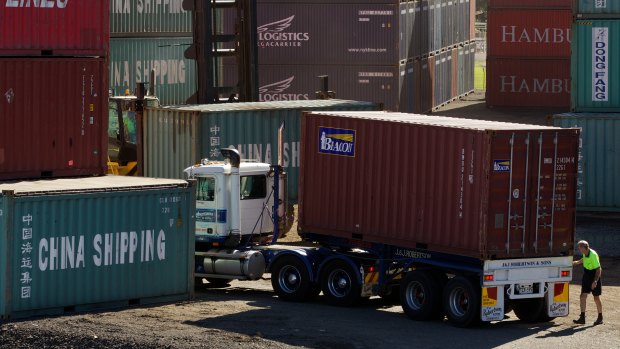- Exclusive
- Business
- The economy
- Roads
This was published 6 years ago
Restrictions on privatised ports adding to Sydney's gridlock: Deloitte report
By Matt Wade
Hundreds of thousands of trucks could be shifted from Sydney’s roads by a new container terminal at Newcastle, but secret restrictions introduced during the privatisation of NSW ports are preventing its development.
The Australian Competition and Consumer Commission is now investigating the restrictions, which were introduced when Port Botany and the Port of Newcastle were being privatised.
This raises the possibility of the federal government’s competition watchdog taking action over the arrangements imposed during the privatisation process.

Port Botany now handles about 2.4 million containers a year and that is forecast to rise to 5 million by 2040.Credit: Jon Reid
Modelling by Deloitte Access Economics has found a new container terminal at the Port of Newcastle would immediately slash the number of shipping containers transported through Sydney’s transport networks by half a million, rising to 1.1 million by mid-century.
The operator of Newcastle’s port wants to build a container terminal but claims that a new facility is not viable because of constraints imposed at the time of privatisation.
Roy Green, the chair of the Port of Newcastle, said the efficiency of our port system "is being compromised by the restrictive arrangements that the government set up at the time of privatisation".
Deloitte's analysis, which was commissioned by the Port of Newcastle, draws attention to the impact of tolls on the movement of containers to and from Port Botany. It will cost $60-$80 in tolls to move a container west of Port Botany in future, the report estimates.
Mr Green said the business model for the WestConnex motorway was “thoroughly tied up” with restrictions favouring Port Botany.
In 2016 The Newcastle Herald revealed a secret NSW government agreement to compensate the operator of Port Botany and Port Kembla for loss of trade to a competing container terminal in Newcastle. Under the "strictly confidential" arrangement, Newcastle would have to make "cross payments" of about $100 per container unit (about $1 million per vessel) it handled above a threshold of 30,000 a year.
When asked about the restictions, a NSW Treasury spokesman said no "cross payments" are triggered until a threshold container throughput is reached and the number of containers moving through the port of Newcastle was now less than one third of the threshold.
Port Botany now handles about 2.4 million containers a year and that is forecast to rise to 5 million by 2040. Deloitte estimates more than 90 per cent of container movements within the metropolitan area are by road.
In 2013, Port Botany and Port Kembla were leased for 99 years for $5.07 billion. A similar lease was awarded for the Port of Newcastle in 2014 for $1.75 billion.
A spokesman for NSW Treasury told the Herald that "the port transaction arrangements do not prohibit the development of a container terminal and allows for the organic growth of container traffic through Newcastle".
But Mr Green described that response as "disingenous" because the restrictions meant a viable container terminal in Newcastle was not possible.
The ACCC has written to a number of organisations “to seek information relating to the viability” of a container terminal at the Port of Newcastle. The letter says the commission has “concerns about arrangements that may limit or prevent the development of a container terminal at the Port of Newcastle”.
Those contacted by the ACCC now include NSW Ports, the private operator of Port Botany and Port Kembla. NSW Ports chief executive Marika Calfas told Fairfax Media: “We were contacted earlier this week by the ACCC and will be sharing our expertise and knowledge about container port and supply chain logistics and efficiencies with them.”
The Deloitte report said port restrictions were hampering efficient trade in NSW and greater competition from a new container terminal in Newcastle would also improve port productivity by 2.5 per cent boosting the state economy.
“NSW relies on ports for almost all of our international trade, and so a lack of competition both reduces port efficiency and increases landside transport costs,” it said.
The Deloitte study found a quarter of the state’s imports and 38 per cent of exports now moving through Port Botany are destined for or originate from parts of the state that are closer to the Port of Newcastle.
“And yet these are all being funnelled into crowded Sydney roads and co-mingled with passenger rail for shipping through Port Botany,” said Mr Green.
Mr Green, a former dean of the University of Technology, Sydney business school, said the $60-$80 in tolls trucks will pay to move containers from Port Botany in future was a “non-tariff barrier on exports” from NSW.
The NSW Treasury spokeman said about 85 per cent of containers travel within a 40-kilometre radius of Port Botany and that "considerable future growth in demand for products delivered by containers is predicted to occur in the south-west region of Sydney", which is closer to both Botany and Port Kembla than Newcastle.
Tresurer Dominic Perrottet said the revenue generated from the long-term lease of NSW ports has "helped the government fund its $80.1 billion infrastructure strategy across the state".
Opposition Leader Luke Foley has welcomed the ACCC inquiry.